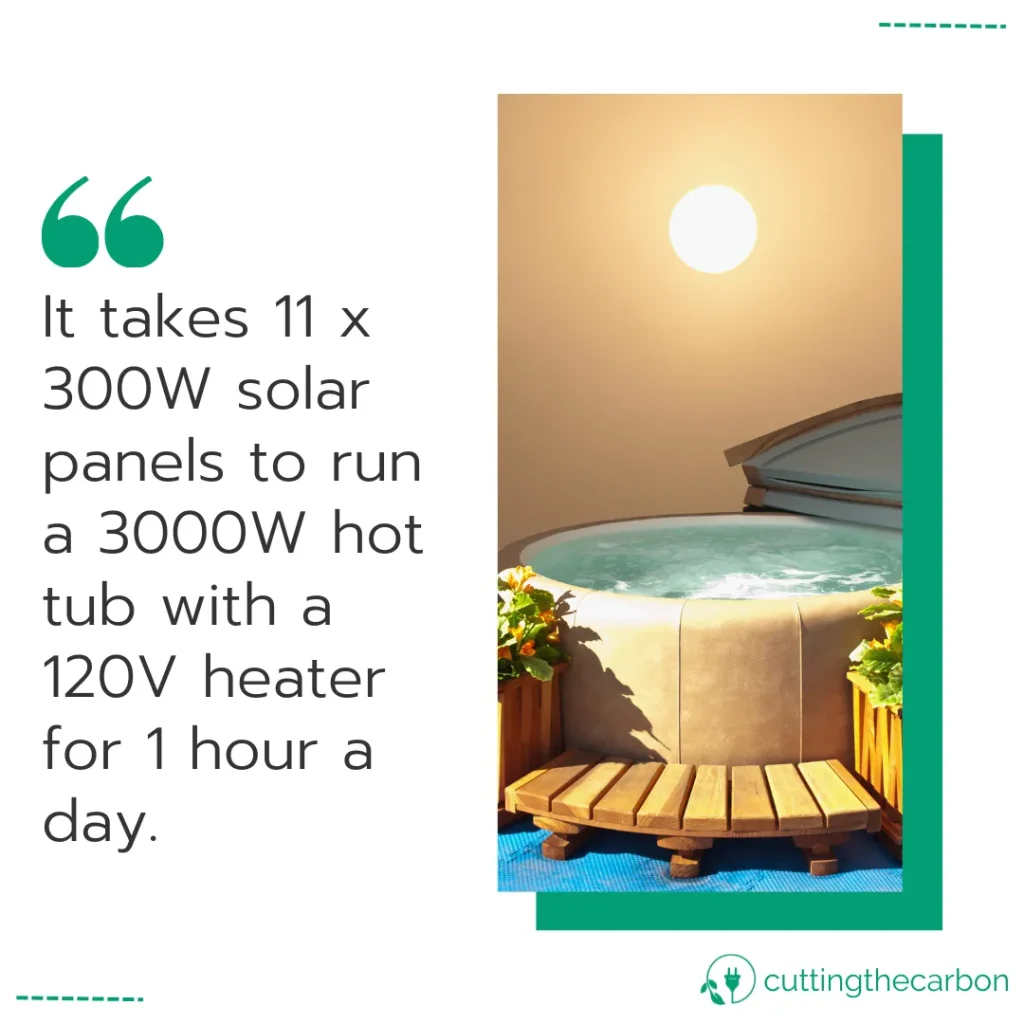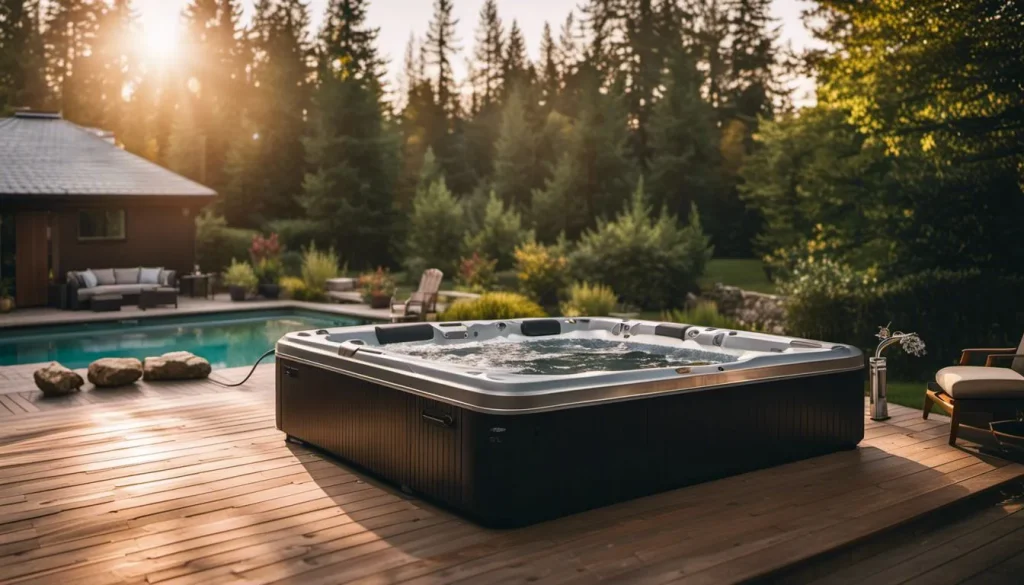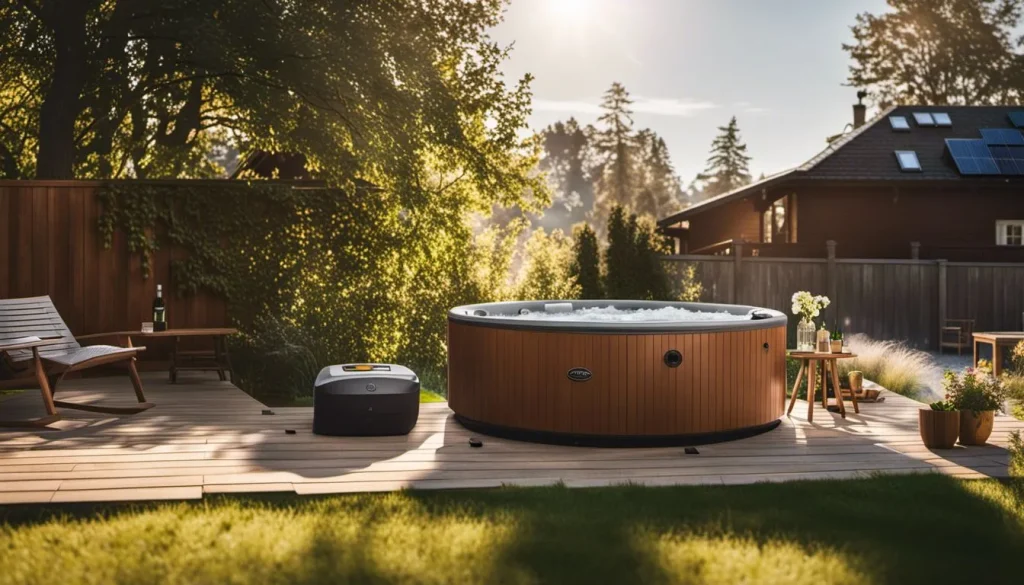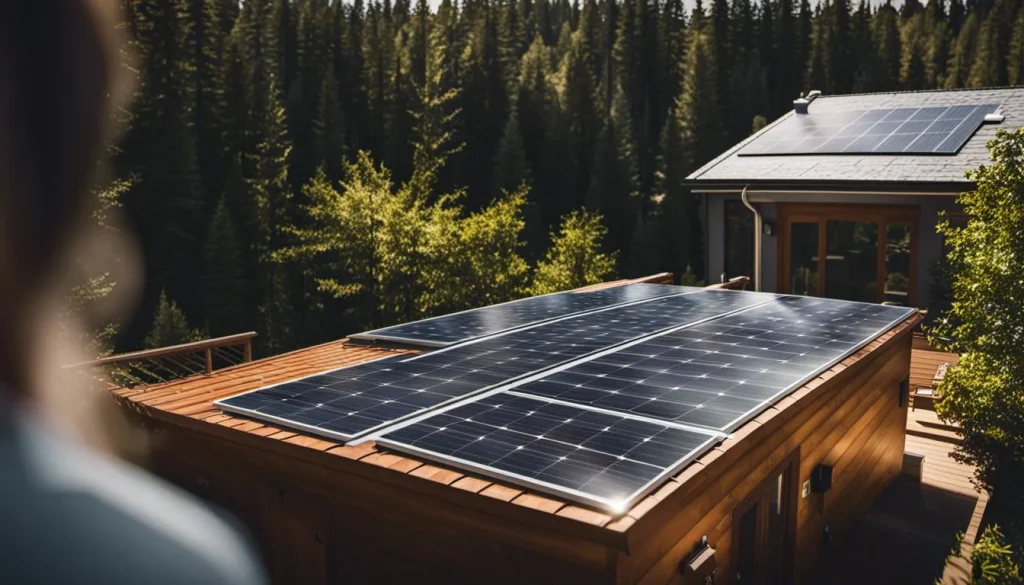Enjoying a hot tub by harnessing free energy from the sun, sounds like a great idea However, figuring out how many solar panels you would need may be daunting. This guide explores the calculations and factors that determine how many panels are necessary to power your hot tub year-round.
Some Points To Consider:
- Solar power can indeed run a hot tub or jacuzzi, but the number of panels needed depends on factors like energy consumption and the location’s sun exposure.
- A typical solar-powered system for a hot tub requires around 2000-3000 watts of solar panels and a 24-volt 250Ah battery.
- Solar power is feasible year-round but faces challenges in the UK due to reduced sunlight during winter months. Efficient PV panels and high-capacity batteries help overcome these challenges.
- By harnessing solar energy, you can potentially save around £255 per year in energy expenses, with an average payback time of approximately 17 years.

Understanding Solar Power and Hot Tubs
Solar power can indeed be used to run a hot tub, but it is important to understand the energy consumption of a hot tub and how solar power works.
Can solar power run a hot tub?
Solar power has the capacity to run a hot tub or jacuzzi. Utilising solar energy, you can effectively heat and maintain your spa’s temperature. A typical solar-powered system for a hot tub necessitates around 2000-3000 watts of solar panels, in conjunction with a 24-volt 250Ah battery.
The process involves converting sunlight into electricity through photovoltaic (PV) panels – but these only convert about 20% of the captured sun’s energy into usable power.
An alternative or supplementary practical choice is using solar thermal collectors which are significantly more efficient, transforming up to an impressive 75% of the sun’s energy directly into heat.
Therefore, running your hot tub on this renewable energy source is not just environmentally friendly but also technically feasible.

How much energy does a hot tub or jacuzzi consume per hour?
A hot tub is a substantial energy consumer, with usage varying based on factors like its size and temperature. The heart of any hot tub system is the heater, which pulls considerable electricity to heat up the water.
A typical 120V heater used in smaller hot tubs can consume approximately 1.5 kilowatts per hour, whereas larger 240V heaters use around 6 kilowatts per hour.
Breaking it down further to put things into perspective; an average hot tub’s energy consumption clocks around 300 kWh per month.
Therefore, given that there are roughly 730 hours in a month (24 hours multiplied by about 30 days), this means your average hot tub will consume about .41 kWh or slightly less than half a kilowatt-hour every single hour of continuous operation.
Evaluating the Sun’s Energy in Your Location
Can solar power run a hot tub in the UK? We need to determine if year-round solar power is feasible for hot tubs and evaluate the challenges of solar power during winter months.
Is year-round solar power possible for a hot tub or jacuzzi?
Yes, year-round solar power for a hot tub is feasible but it hinges on several criteria. These include your geographical location and the consistency of sunlight throughout the year.
Countries like the UK experience less sunlight in winter, posing challenges to sustaining solar power. The efficiency of solar panels drops as temperatures fall and shorter days result in fewer hours of sunlight for energy conversion.
However, technological advancements have given rise to more efficient electric PV panels that convert 20% of the sun’s energy into usable power even under low-light conditions. High-capacity batteries also enable storing surplus energy during summer months for use in winter which aids consistent operation.
While achieving continual solar-powered hot tub usage can be complicated due to seasonal fluxes in sunshine availability and temperature fluctuations affecting panel efficiency, with diligent planning involving suitable panel selection and maximised battery storage potential it becomes achievable.

Challenges of solar power in winter
As mentioned above, solar power faces unique challenges during the winter months. One major challenge is the reduced amount of sunlight available, as the sun’s energy is lower compared to the summer months.
This means that solar panels may not generate as much electricity to meet the hot tub’s energy needs. Additionally, overcast skies and rainy weather can further decrease solar panel efficiency and energy production.
To address these challenges, it is important to properly size the solar panel system based on winter conditions and account for system losses. It is also recommended to have additional capacity, up to 50%, to ensure a reliable power supply even on low-sun days.
Calculating the Number of Solar Panels for a Hot Tub
To determine the number of solar panels needed to power a hot tub, you must consider factors such as energy consumption, location’s sun exposure, and battery storage capacity.
How many solar panels are needed?
To power a hot tub using solar energy, you will need approximately 2000 watts of solar panels and a 24-volt 250Ah battery. The number of solar panels required depends on the hot tub’s energy consumption and the amount of sunlight available.
It is also recommended to have some extra capacity, around 50%, to account for system losses and days with less sunlight. By using these calculations, you can ensure that your hot tub runs efficiently on clean, renewable energy from the sun.
The role of batteries in solar power
Batteries play a crucial role in solar power systems by storing the energy generated from the sun. In a solar-powered hot tub, batteries are recommended to ensure a continuous power supply even when the sun is not shining.
A 24-volt 250Ah lithium phosphate battery is commonly used for this purpose due to its deep-cycle capabilities and long life. These batteries store the excess energy produced during the day so that it can be used later, such as during nighttime or on cloudy days.
By utilising batteries in conjunction with solar panels, hot tub owners can enjoy consistent and reliable power without relying solely on sunlight.

The Economics of Solar-Powered Hot Tubs
Solar-powered hot tubs offer significant savings and a relatively quick payback time due to reduced energy costs.
Estimating solar savings and payback time
Solar-powered hot tubs can offer significant savings on electricity costs. By harnessing the power of the sun, you can potentially save around £255 per year in energy expenses. However, it’s important to consider the upfront cost of installing a solar panel system for your hot tub, which typically amounts to approximately £4,350.
With these figures in mind, it would take approximately 17 years to recoup the initial investment through energy savings. Keep in mind that these estimates are based on average usage and may vary depending on factors such as location and individual consumption patterns.
Nonetheless, investing in solar power is not only environmentally friendly but also a practical way to reduce your carbon footprint and save money in the long run.
Building A Solar Powered Hot Tub Video
Benefits and Downsides of Solar Powered Hot Tubs
Solar powered hot tubs offer numerous benefits such as being environmentally friendly and cost-effective, but they also come with potential challenges and limitations.
Environmental-friendly and cost-effective
Solar-powered hot tubs are not only environmentally friendly but also cost-effective. By harnessing the power of the sun, solar panels generate clean energy to heat your hot tub without relying on grid electricity.
This means you can reduce your carbon footprint while enjoying a relaxing soak. Additionally, solar panels have a long lifespan and require minimal maintenance, saving you money in the long run.
With the potential for significant savings on energy costs, going solar for your hot tub is both an eco-conscious and economically smart choice.
Potential challenges and limitations
The solar panels needed to power a hot tub in the UK may face potential challenges and limitations. These include:
- Limited sunlight: The UK has relatively less sunshine compared to other regions, which can affect the efficiency of solar panels in generating electricity.
- Low sun angles: In winter months, when hot tub usage is more common, the angle of the sun is lower, leading to reduced solar energy absorption.
- Overcast days: Cloudy and overcast weather can significantly impact the amount of sunlight reaching the solar panels, resulting in decreased energy production.
- Winter temperature: Solar thermal panels may struggle to heat the water to desired temperatures during colder months, affecting their effectiveness in operating a hot tub.
- Higher energy consumption: Hot tubs tend to consume significant amounts of energy, and solely relying on solar power may not be sufficient to support continuous usage without additional battery storage or grid assistance.
- Space requirements: Installing a sufficient number of solar panels for a hot tub can require a sizable space allocation on rooftops or outdoor areas such as gardens, which may pose constraints for some homeowners.
- Installation costs: The initial investment for installing a solar-powered system for a hot tub can be expensive due to the cost of solar panels, batteries, and associated equipment.
- Maintenance and upkeep: Periodic cleaning and maintenance of solar panels are necessary to ensure maximum efficiency and optimal operation throughout the year.
How Many Solar Panels To Run A Hot Tub? Final Thoughts
Running a hot tub with solar power is not only possible but also environmentally friendly and cost-effective. To determine the number of solar panels needed, calculations based on energy consumption and location-specific solar data are crucial.
With the right setup and battery storage, you can enjoy your hot tub year-round while minimising your carbon footprint and saving money on electricity bills.
Frequently Asked Questions
How many solar panels do I need to run a hot tub?
The number of solar panels needed to run a hot tub depends on several factors, including the size of the hot tub, its energy consumption, and the amount of sunlight available in your location. It is best to consult with a professional installer who can assess your specific needs.
Can solar panels fully power a hot tub?
In most cases, it is unlikely that solar panels alone will be able to fully power a hot tub throughout the year. Hot tubs require a significant amount of energy, especially during colder months or periods of frequent use. Solar panels can complement an existing energy source or help reduce overall energy consumption.
What other equipment may be required besides solar panels for running a hot tub?
In addition to solar panels, you may need other equipment such as batteries or an inverter system for storing and converting the collected solar energy into usable electricity for your hot tub. A control system may also be necessary to manage and monitor the charging process.
Are there any government incentives for installing solar panels for running a hot tub?
Government incentives and rebates vary depending on your location and current policies. It is advisable to check with local authorities or renewable energy agencies to see if there are any financial incentives available for installing solar panels specifically for powering your hot tub.

